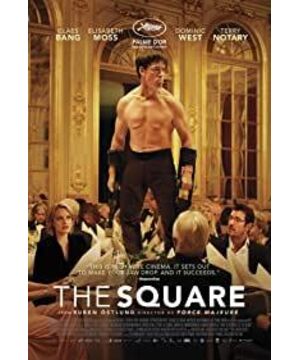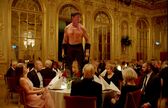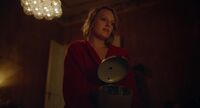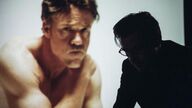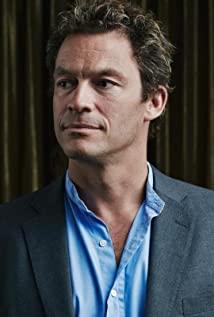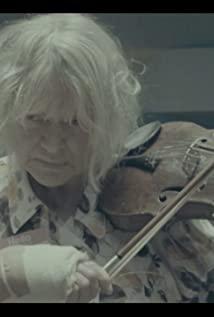"The square is a temple of trust and care, in which we have the same obligations and powers."
A contemporary art museum in Sweden is busy adding fat and powder to the upcoming new exhibition "Plaza", hoping to have the opportunity to hype up the special exhibition and make it popular overnight. But Christian, the usually dashing, calm and personable curator, was a little absent-minded, because his wallet and mobile phone were taken away in the crowded square that he must pass through every day for work.
While he's figuring out how to pull off a pickpocket, he has to deal with overly attentive female art reporters, a marketing team whose brains are a little obsessive, and arty but difficult donor VIPs. As the development time is getting closer, the following accidents have made life chaotic, everyone's madness index has gradually increased, and the trust and care advertised in the square is about to collapse...
The story takes place in a social welfare paradise: Nordic Sweden. In this country, pets are allowed to go to work, men share the responsibility of taking care of children, silver-haired elders attend rave parties, children can scold adults, and parents know how to apologize to their children. In this highly developed civilization, extremely high equality index, rich economy, and tasteful country in every corner, darkness still exists. In the film, beggars all over the street are deliberately photographed, which is in sharp contrast with the elegant and high-class people in the art circle. When the art museum launched the work "Plaza", which symbolizes "the temple of trust and care", the curator was robbed of property in the plaza because he believed in the innocence of passers-by. How ironic.
The viewing experience of "Crazy Art Museum" can be described as a thorn in the back, as uncomfortable as accidentally sticking the thorn in the throat when eating fish. For example, during a lecture, an audience member suffering from Tourette Syndrome kept clapping and swearing. This behavior was really inappropriate, but the other party was not malicious and unrestrained, and the event continued in an embarrassing and disturbing atmosphere. Another example is when the female reporter questioned the curator's behavior, the installation art in the background intermittently made a loud noise, interrupting the dialogue between the two from time to time. The most classic scene is when the art museum hosts a dinner party, inviting performance artists to dress up as orangutans as an entertainment show, but in the end, they overwhelm the venue. As far as performance is concerned, he perfectly interprets the brutality and uncontrollability of the orangutan, which can be said to be a gold-winning performance; but in the name of art, can one violate others and use violence?
Every scene in "Crazy Art Museum" is carefully arranged, and each plot has multiple metaphors, including the stereotype of the class gap, the contrast between barbarism and civilization, where is the line between art and hypocrisy... and so on. But for me, the core focus of the whole film is actually the analysis of power relations, especially the power of "interpretation".
At the beginning of the film, the reporter interviewed the director of the museum about the concept of curation, and his answer at that time was:
"For example, this bag, if I put it in an art gallery, is it a work of art?"
When I heard this passage, I was reminded of Du Xiang's classic masterpiece "Fountain" (1917), which is the signed urinal. What is the difference between the signed urinal displayed in the museum and the urinal with "Come here" written on it in the public toilet? Regardless of the complex meaning of this work, who has the right to speak about the value of art? Who has the power to sell the idea of art?
Taste and appreciation require capital to achieve. Without money to learn knowledge and appreciate the methodology, it is easy to get trapped in curatorial concepts that are sloppy and convoluted, and cannot find an outlet.
"Crazy Art Museum" uses art appreciation as a metaphor, magnifies the analysis of power relations to universal human nature, and accurately examines gender, class, workplace... Interpret the subordinates, the media interpret the audience. If the power of interpretation is not used carefully and arbitrarily, misunderstandings and conflicts will follow, which leads to all kinds of "savage" counterattacks in the film.
Following the "Marriage Storm" (Force Majeure, 2014), Swedish ghost director Ruben Oslen once again used his "embarrassing moments" to expose the darkness and scars of human nature. His cold, precise and imaginative portrayal made this film a winner. Cannes Film Festival Palme d'Or.
Dogs and babies popping up in the office, orangutans in an apartment, noisy installations, dazzling trash in a perfectly clean space. These "playing" moments violated the magical power that the movie was trying to create, sucking the audience into the world in the play, but instead woke everyone up and pushed them back to the real world. In addition to stimulating the audience to think about "why", these noises in the movie are also reflections on interpretation of power, freeing the audience from the state of "entering the play" following the development of the plot, and then "playing" to think about themselves, the movie and the world The relationship between.
The whole film "Crazy Art Museum" is like walking a tightrope, walking on a terrifying balance all the time, making people sweaty palms watching. However, the reverberating theme music in the film is Yo-Yo Ma and Bobby McFerrin's reinterpretation of Baja/Cournot's "Ave Maria" with vocals and cello by French composer Charles Cournot. Gounod) is an ode to an original melody with decomposed chords from JS Bach's Well-Tempered Collection. The twelve equal temperament divides the octave evenly into twelve tones, so rational and harmonious, it is really interesting to compare the various conflicts and skews in the film.
Art is like a movie lens, magnifying all human nature under observation, sometimes too fake to be embarrassed, sometimes too cold to look directly. But who decides that an object displayed in a museum can be called a work of art, and who decides whether to laugh or cry when watching a movie? In art/film, we have the same obligations and powers.
View more about The Square reviews


